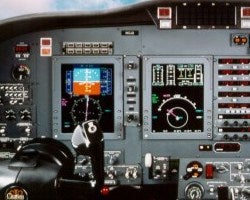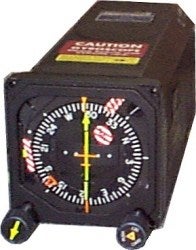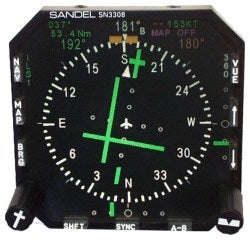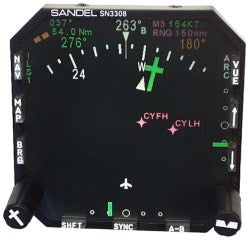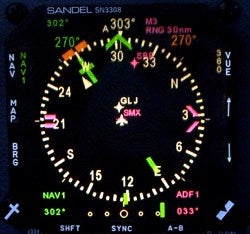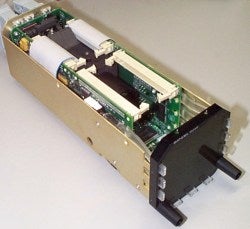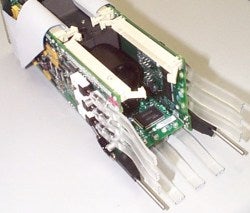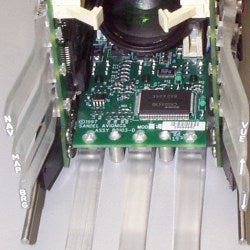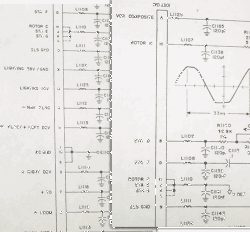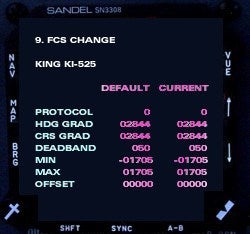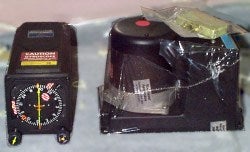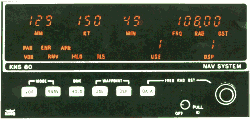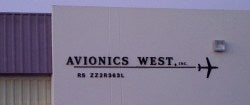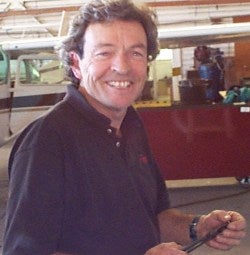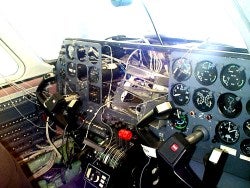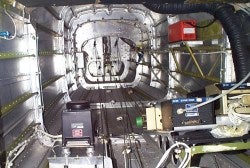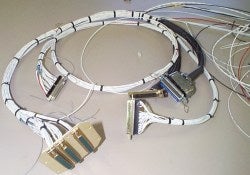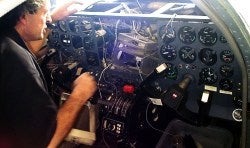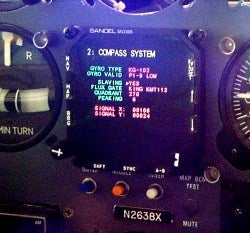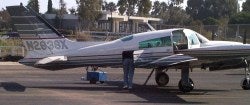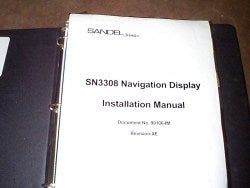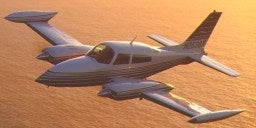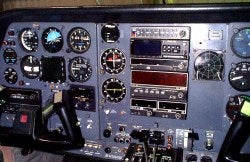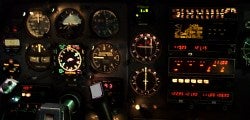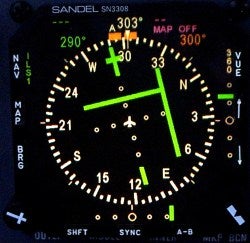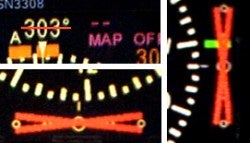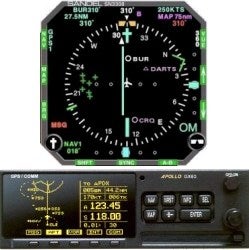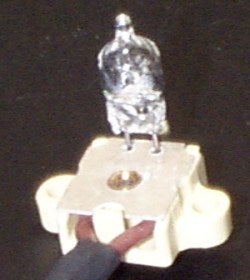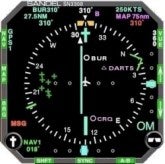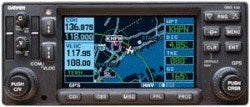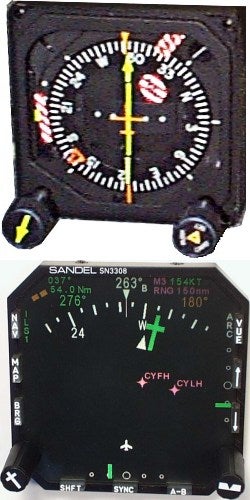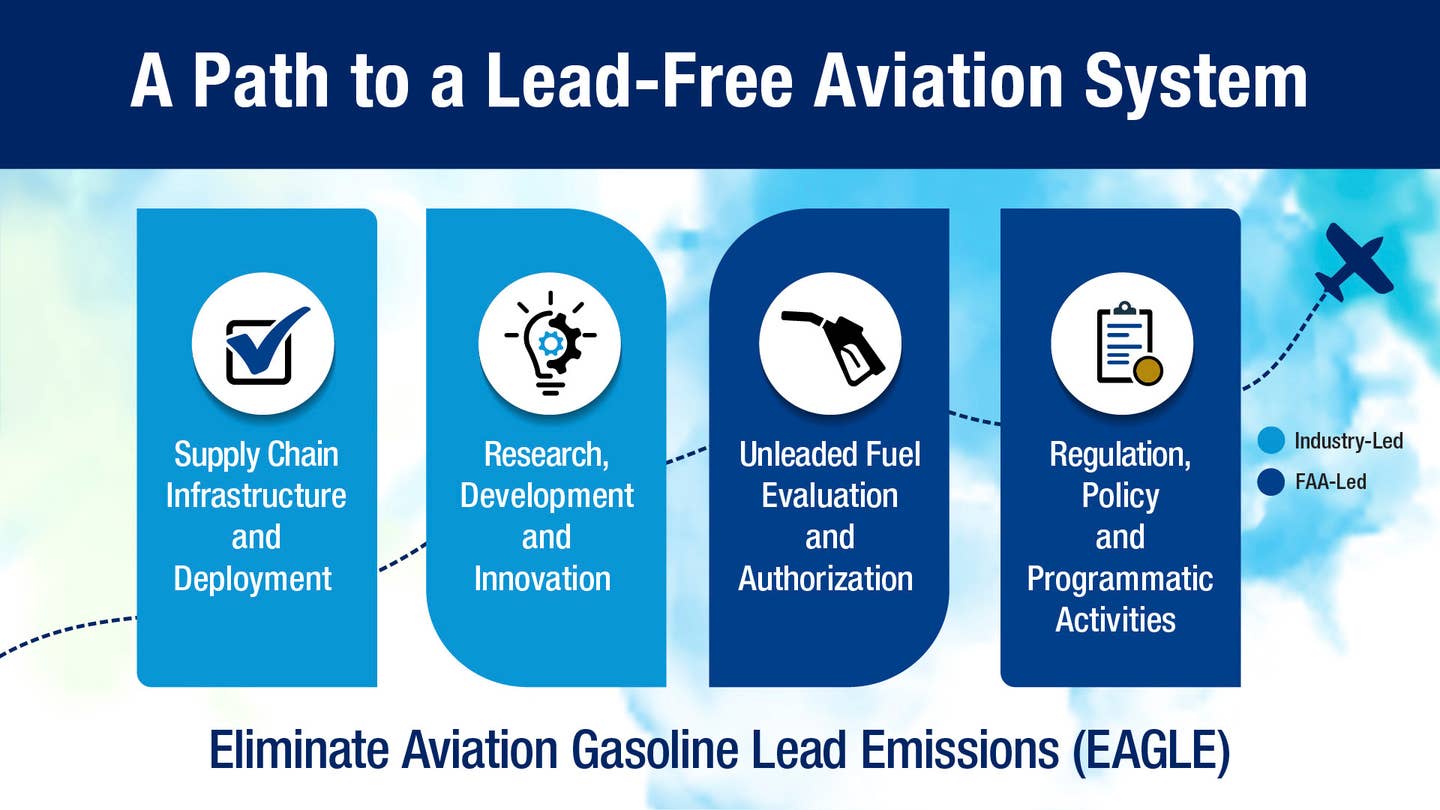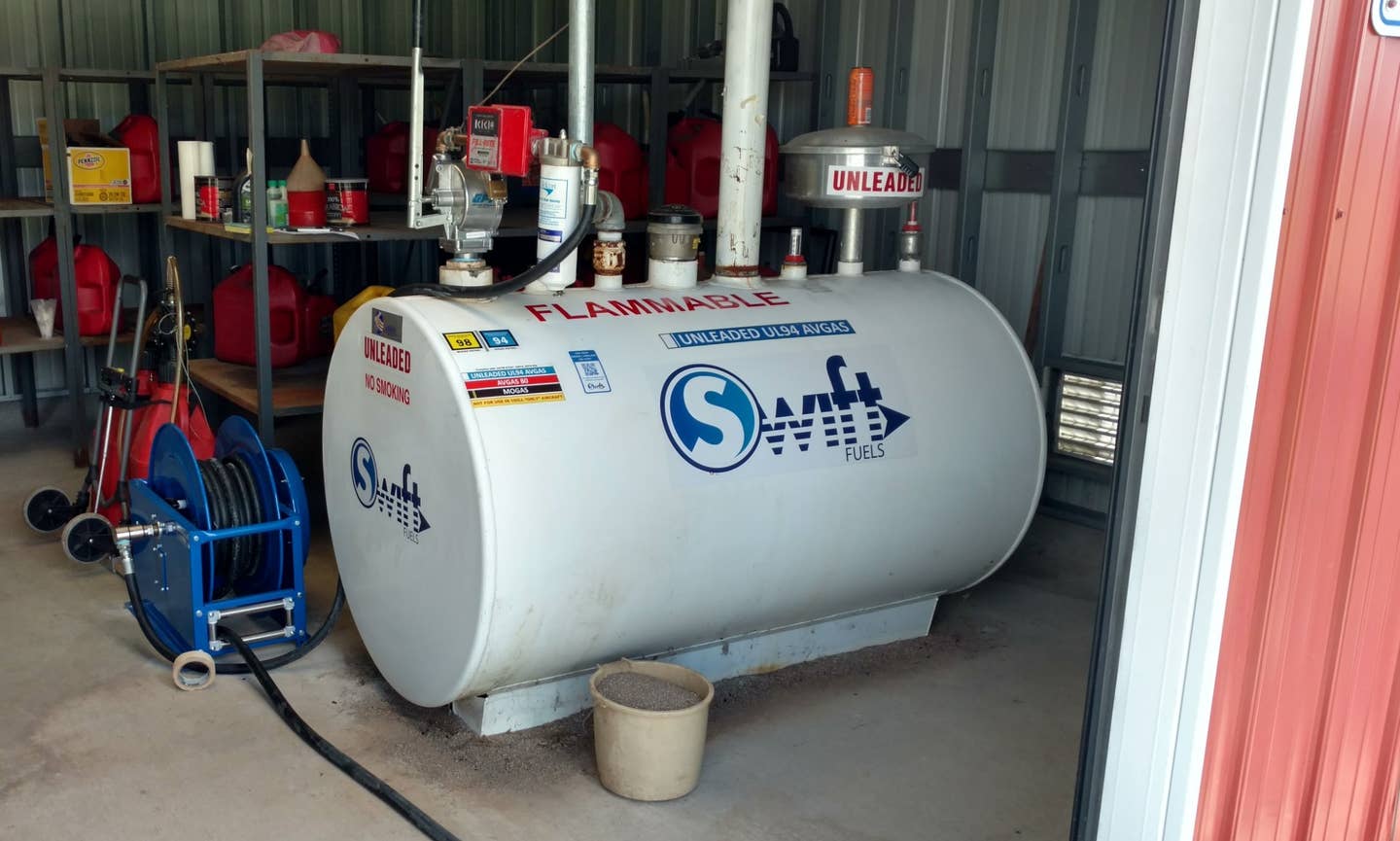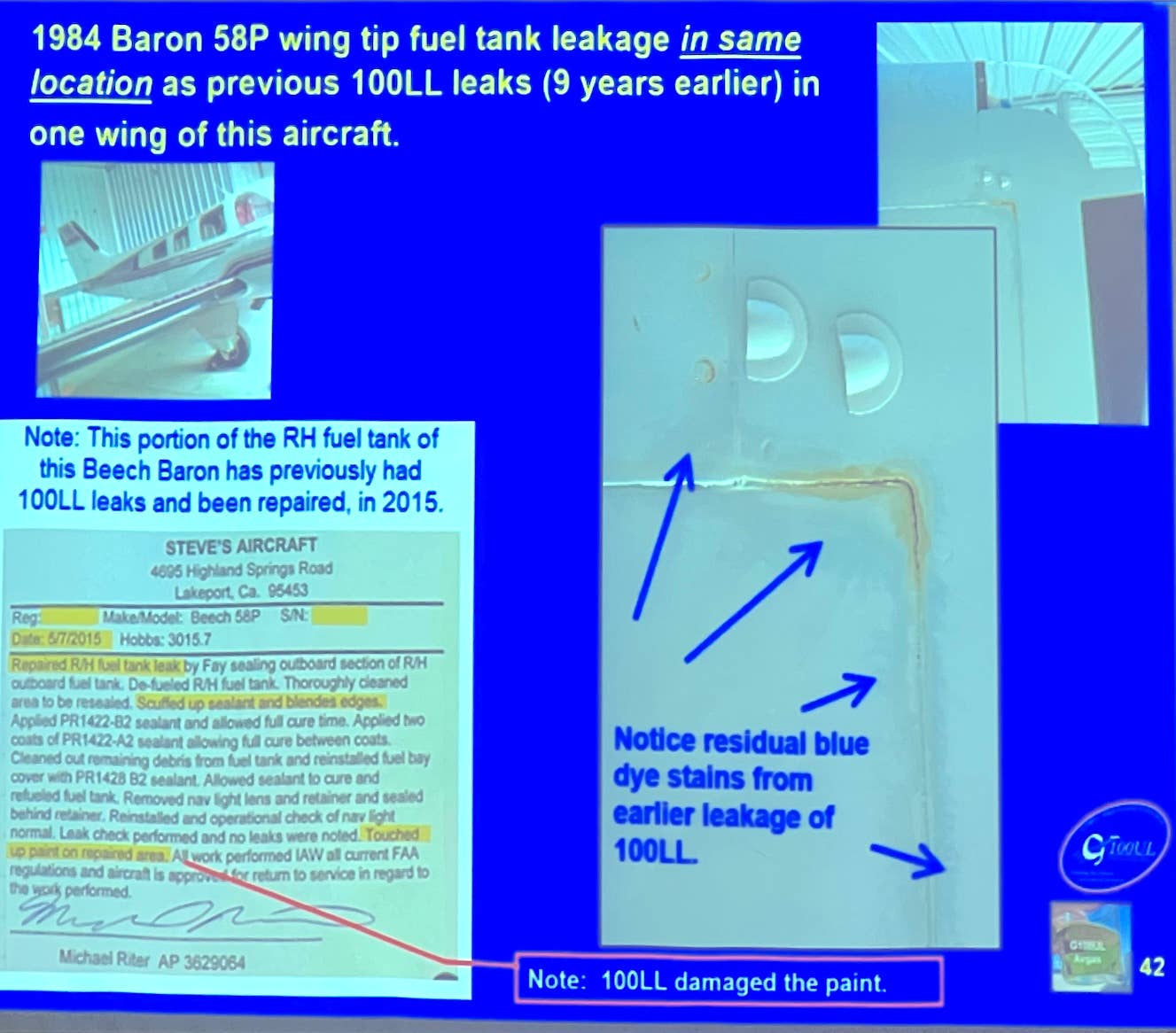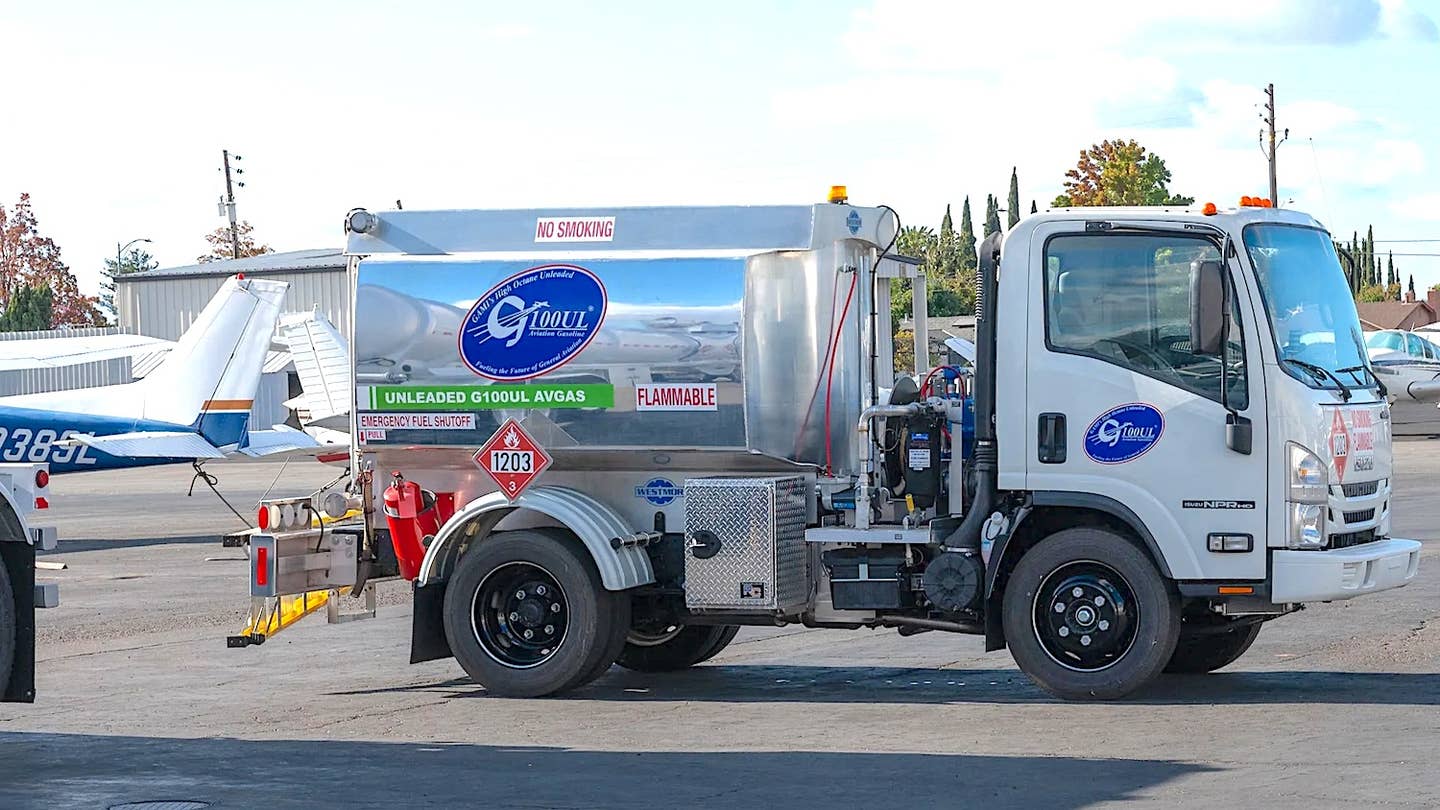Sandel Avionics SN3308 Electronic HSI: EFIS Becomes Affordable
The SN3308 is the world’s first three-inch electronic HSI: small enough to fit in any GA panel, and at $7,895, priced about the same as an ordinary mechanical HSI. But, that’s where the similarity ends, because the SN3308 is a magnificent multifunction color display that serves as an HSI, RMI, and moving map, and provides an integrated EFIS-style readout of nav data from your VOR, GPS, Loran, ADF, DME and marker beacon receivers. AVweb editor Mike Busch recently installed one in his Cessna 310 and still can’t wipe the smile from his face. Here’s Mike’s in-depth review of what he calls “a glass cockpit for the rest of us.”

 A couple of months ago, Ihad Avionics West replace some of the avionics in my 1979Cessna T310R. In particular, I changed out my decade-old Loran for a II Morrow GX50approach-certified GPS. At the same time, I yanked out the airplane's original-equipmenthorizontal situation indicator - an old vacuum-driven Century NSD-360 - and installedthe new Sandel Avionics SN3308 Electronic HSI in its place.
A couple of months ago, Ihad Avionics West replace some of the avionics in my 1979Cessna T310R. In particular, I changed out my decade-old Loran for a II Morrow GX50approach-certified GPS. At the same time, I yanked out the airplane's original-equipmenthorizontal situation indicator - an old vacuum-driven Century NSD-360 - and installedthe new Sandel Avionics SN3308 Electronic HSI in its place.
My decision to install the Sandel SN3308 was highly uncharacteristic, because anyonewho knows me (or has read much of my writing) knows that I'm not exactly what you mightcall an "early adopter" when it comes to new technology for my airplane. I tendto avoid buying anything for the airplane - at least anything expensive orsafety-critical - until it has proven itself in the field for at least a few years, and Ioften advise other aircraft owners to do the same. When Cermicromecylinders were all the rage in the early 1990s, I urged caution. As early as 1991, Istarted discouraging owners of low-utilization aircraft from using
So why in heaven's name would I install something like the Sandel SN3308, a brand-new,relatively unproven, moderately expensive gadget that uses bleeding-edge technology andcomes from a new, start-up company with no track record in aviation? A primary flightinstrument, no less?
That's easy to explain: I simply couldn't help myself. Once I took a close, analyticallook at the Sandel SN3308 EHSI, I simply had to have one. And once I started flyingwith the SN3308, I simply can't imagine how I ever managed without it. I'm notexaggerating. Sandel's new instrument is that compelling.
The anatomy of compulsion
|
I first read about the new Sandel instrument shortly after the prototype was firstunveiled at NBAA and AOPA in October 1997. Not long afterwards, Tom Rogers of Avionics West saw the unit at the annualAircraft Electronics Association trade show and told me how impressed he was. I first sawthe SN3308 "in the flesh" at Oshkosh in August 1998, and drooled over it fordays afterwards. But to be honest, I was too much of a skinflint to spring for the $8,000purchase price plus installation. So beyond lusting in my heart, I did nothing.
A couple of months later, I had the opportunity to take a ride from Wichita toWashington, D.C. and New York and back in one of Cessna's new Mach .92 Citation X musclemachines. After dropping off all the pax at DCA and TEB, it was just me and the two pilotson the return flight to ICT. So naturally, I spent the whole time standing in the cockpitdoor looking over the shoulders of the cockpit crew. The Citation X was equipped with thevery latest Honeywell glass cockpit setup, with five giant 8-by-10-inch color displaystaking the place of virtually all conventional flight, navigation and engine instruments.I asked a million questions about how the system worked, and reignited my visceral lust toput an EFIS in my airplane.
|
Not long thereafter, my vacuum-driven NSD-360 HSI started acting up. On severaloccasions, the slaved heading gyro suddenly wound up 20 or 30 degrees in error, causingthe autopilot to take me on an unplanned off-route excursion each time. Although Isubsequently diagnosed the problem as being a clogged central vacuum filter, it remindedme that the NSD-360 was a pretty vulnerable instrument, and one that had required (andwould continue to require) overhauls every few years at a cost of around $2,800 a pop.Somehow, that made the $8,000 price of the Sandel seem a lot more reasonable.
In October 1998, I saw the Sandel SN3308 again at AOPA Expo in Palm Springs. Sandel'sbooth was only two aisles down from AVweb's booth, and I found myself going back time andagain to take another look and ask more technical questions of Sandel founder andpresident Gerry Block. The more I learned about the instrument, the more impressed Ibecame. By the time Expo was over, I'd decided that I couldn't hold out any longer. Iordered a unit from Sandel Avionics and asked Tom Rogers to put me on the Avionics Westschedule for what would turn out to be a month-long installation effort.
The SN3308: What it is...
|
The Sandel Avionics SN3308 is the first really new general aviation flight instrumentto come along in the last 20 years, and certainly the first one expressly designed for usein the GPS age. It's the first all-electronic flight instrument to fit in a three-inchpanel opening, and consequently the first one that can be accommodated by a standard GAinstrument panel layout.
Accomplishing this was no mean feat. The largest conventional CRT or LCD color displaysthat will fit in a standard three-inch opening have a viewing area of about 2 1/4 inchessquare. That's simply not big enough for a primary flight instrument. An EHSI based onsuch a display would have a compass rose substantially smaller than a conventionalthree-inch mechanical instrument, and would have no room left for all the otherinformation that an EHSI should display.
The technological breakthrough that makes the SN3308 possible is a unique opticalsystem that uses a small but extremely high-resolution color LCD display that's roughly aninch square and located near the rear of the instrument case. The image from that displayis then projected by means of an extremely sophisticated optical system onto arear-projection screen which constitutes virtually the entire face of the instrument. Thisapproach makes it possible to use literally the entire 3-by-3-inch instrument face asuseable display area. The resulting presentation is slightly larger and much easier toread than the face of a three-inch mechanical HSI. The display is razor-sharp anddrop-dead gorgeous.
The Sandel SN3308 is also the first electronic HSI that's reasonably affordable for theowner of a piston aircraft. Of course, "affordable" is a relative term. TheSN3308 sells for just under $8,000, which is quite comparable to the price of aconventional three-inch mechanical HSI system like a Bendix/King KCS-55A or CenturyNSD-1000. By the time you get it installed, you're looking at something between $10,000and $14,000 depending on what equipment you already have in the airplane, what additionalstuff you need to buy (such as a remote electric heading gyro and/or flux gate), andwhether you buy those new or reconditioned. In any case, that's not exactly chump change.
But to put things in perspective, consider that until Sandel introduced the SN3308, thelowest-cost electronic HSI available was a Bendix/King EFIS 40 system that cost upwards of$50,000 by the time it's installed. Furthermore, the EFIS 40 utilizes a four-inch cockpitdisplay that is simply too big to fit in most existing GA aircraft without tearing theinstrument panel apart and starting over. If you fly anything smaller than a King Air, anEFIS 40 is probably pretty much out of the question.
...and what it does
The Sandel SN3308 provides an integrated display that combines all your navigationinformation in one place. In addition to the usual functions of a slaved HSI, the unitoffers the additional functions of an RMI, GPS-driven moving map, weather-avoidancedisplay, ADF indicator, DME indicator, remote marker beacon annunciator, and all theremote annunciation and switching functions required for an approach-approved GPSinstallation. Truly one-stop shopping for navigation information.
Compass functions: The EHSI heading display is driven by an externalgyro-stabilized heading source. If the airplane already has a heading indicator with asyncrho ("bootstrap") output, the SN3308 can obtain its heading information fromthat. Alternatively, the instrument can interface with almost any conventionalremote-mounting directional gyro (Bendix/King, Collins, etc.) and flux gate.
HSI functions: The SN3308 provides electronic analogs of a conventionalmechanical horizontal situation indicator: compass card, heading bug, course pointer,course deviation bar, to/from indicator, vertical deviation (glideslope) indicator, andnav flags. The HSI display is larger and much easier to read than a mechanical instrument.Heading bug and course pointer settings include digital displays that make it easy to setprecise headings and courses to the exact degree. The "NAV" button allows theHSI to be switched among up to four different nav sources (two VOR/ILS receivers and twoGPS receivers), and the HSI pointers change color to indicate clearly which nav sensor isselected (green for Nav1, yellow for Nav2, cyan for GPS).
Sync functions: TheSN3308 features two extraordinarily useful "sync"functions: Heading sync slews the heading bug to the aircraft's present heading, whilecourse sync slews the course pointer to the bearing of the active navaid or waypoint,automatically centering the deviation bar. Thus, "fly present heading" and"proceed direct" each require just a button press rather than a knob-twistingexercise.
|
RMI functions: In case you've never flown with one, an RMI ("radio magneticindicator") is an instrument with a slaved compass card plus two indicator arrows.Typically, one of those arrows is hooked to the aircraft's ADF, while the other is drivenby a VOR receiver. The arrows point toward the navigation station (NDB or VOR), and theslaved compass card allows you to read magnetic bearing to the station. The RMI is anextremely useful instrument for maintaining situational awareness, and is especiallyhelpful for certain maneuvers such as DME arcs, course intercepts and holding patternentries. The SN3308 incorporates extended RMI functionality by displaying two"bearing pointers," each of which may be enabled or disabled by the pilot andswitched to any of the nav sensors connected to the instrument, including GPS, VOR and ADFreceivers. On approach, for example, the HSI could be displaying the ILS, while the #1bearing pointer points toward the outer compass locator (ADF receiver) and the #2 bearingpointer points toward the airport (GPS).
Map functions: The SN3308 incorporates a high-resolution moving map displaywhich can be enabled or disabled by pressing the "map" key. At present, the mapdisplays only waypoints provided by the GPS receiver, but the next software releaseincorporates an internal Jeppesen NavData database of airports, navaids and special-useairspace to support the map display. (More about this later.) Map range is adjustable bypressing the up- and down-arrow keys. The map function can be superimposed over theconventional HSI display, in which case it provides a 360-degree view with the aircraft inthe center. Pressing the "vue" key toggles the display to a 120-degree arc viewwith the aircraft at the bottom of the display and a forward-only map display. The map isreally beautiful, and makes the tiny monochrome map displays offered by most panel-mountGPS receivers look like a bad joke. (Garmin GNS 430 excepted, of course.)
 Other displays: The corners of the SN3308 display contain alphanumeric displays.The upper-left corner contains the fix name and distance of the currently-active navaid orwaypoint that corresponds to the HSI display, plus the digital course pointer setting.(The fix name is available only if the HSI is switched to GPS, while the distance isderived from either GPS or DME as applicable.) The lower-left corner displays the navsource, distance and bearing associated with the #1 bearing pointer, and the lower-rightcorner displays the same information with respect to the #2 bearing pointer. Finally, theupper-right corner shows the current map mode, map range, and the digital heading bugsetting. The present heading is displayed digitally at the top-center of the instrument,while CDI and VDI displays are shown at the bottom and righthand edges of the display.Various annunciators also appear on the face of the instrument, driven by the markerbeacon receiver (OM, MM, IM), the GPS (MSG, HOLD, APPR, ACTV, ARM, WPT, etc.), and the DME(HOLD). Finally, if the SN3308 is connected to a WX-500 Stormscope, weather returns may bedisplayed as small green Xs on the display.
Other displays: The corners of the SN3308 display contain alphanumeric displays.The upper-left corner contains the fix name and distance of the currently-active navaid orwaypoint that corresponds to the HSI display, plus the digital course pointer setting.(The fix name is available only if the HSI is switched to GPS, while the distance isderived from either GPS or DME as applicable.) The lower-left corner displays the navsource, distance and bearing associated with the #1 bearing pointer, and the lower-rightcorner displays the same information with respect to the #2 bearing pointer. Finally, theupper-right corner shows the current map mode, map range, and the digital heading bugsetting. The present heading is displayed digitally at the top-center of the instrument,while CDI and VDI displays are shown at the bottom and righthand edges of the display.Various annunciators also appear on the face of the instrument, driven by the markerbeacon receiver (OM, MM, IM), the GPS (MSG, HOLD, APPR, ACTV, ARM, WPT, etc.), and the DME(HOLD). Finally, if the SN3308 is connected to a WX-500 Stormscope, weather returns may bedisplayed as small green Xs on the display.
A-B memory: A particularly clever feature of the SN3308 is its capability tokeep track of two separate views, referred to as A and B. You can configure a particulardesired display (map selection, map range, bearing pointers, and 360/120-degree view) inthe A-memory, then press the "A-B" key to switch to the B-memory and set up adifferent display configuration. Now, you can quickly toggle back and forth between thetwo by pressing the "A-B" key. It's an extremely useful feature once you get thehang of it.
Inside the SN3308
During my recent visit to Sandel Avionics just north of San Diego, Calif., I had theopportunity to talk at length with company founder and SN3308inventor Gerry Block about the history of the company and his vision for the future. Ialso had the chance to see the SN3308 opened up and to get familiar with the unusualconstruction and remarkable technology incorporated into the instrument.
|
As you might guess, the inside of the SN3308 is mostly air. The projector lamp, LCDdisplay panel and some very sophisticated optics occupy the rear half of the instrumentcase, and the unusual construction is dictated by the requirement that nothing get in theway to cast shadows on the rear-projection screen that forms the face of the instrument.All the electronics are contained on three full-length circuit boards that hug the bottomand both sides of the instrument case. There is no circuit board on top, facilitatingventilation and maintenance access to the lamp and optics.
One of the three circuit boards houses a high-performance 32-bit microcomputerconsisting of a Motorola PowerPC processor plus a graphics generator, four megabytes ofRAM and four megabytes of non-volatile flash memory. The flash stores the operatingsoftware, user-specific setup and configuration parameters, and (starting with the nextsoftware release) a Jeppesen NavData database of airports, navaids and special-useairspace to support the moving map feature of the SN3308. Sandel makes both software anddatabase updates available for download from the SandelAvionics Web site, whereupon they can be uploaded into the instrument via a data cablethat plugs into a panel-mounted jack without removing the instrument from the airplane(using a laptop computer running Windows 95 or 98).
The remainder of the circuit board space is largely occupied by the logic that supportsthe SN3308's unusually large number of external interfaces, including dozens of analoginputs and outputs plus five serial ports. Also on the circuit boards is a regulatedswitching power supply and circuitry to regulate projection lamp voltage and cooling fanspeed under software control.
The heart of the SN3308 display system is a tiny active-matrix LCD display panel that'sonly about one inch square, yet offers an astonishing 432,000 pixels, organized into480x300 color triads. White light from the projection lamp is split into tri-color beams,then passed through the LCD panel. The resulting image then passes through a series oflenses which focuses it precisely on the rear of the instrument face, a translucentrear-projection screen with its own integrated Fresnel lens to provide uniformedge-to-edge brightness and focus. The result is a razor-sharp color image with no hint ofdistortion or "jaggies."
The front-panel controls deserve special mention. The nine keys - three each along thebottom and both sides of the instrument face - are actually transparent plastic arms thatare artfully arched to avoid casting shadows on the screen. Each arm ends up at apushbutton switch mounted on one the circuit boards. Just ahead of each switch is a tinygreen LED that provides illumination to the keys for night use. The plastic arms serve as"light pipes" and each one has a tiny silvered indentation that serves as a45-degree mirror to direct the light from the LED forward to the tip that the pilot seesas a pushbutton. A truly elegant solution to a thorny mechanical design problem.
The front-panel course and heading knobs are also interesting. Each is attached to ashaft that runs back along the extreme corners of the instrument case until out of harm'sway, then via a tiny universal joint to another shaft that angles inward toward the rearof the instrument behind the optics package. At the end of that shaft is aninstrument-grade optical encoder that reports the precise position of the knob to themicrocomputer.
Interface issues
In order to integrate all this navigation information into a single instrument, theSandel SN3308 needs to interface with virtually all the navigation sensors in theairplane: GPS or Loran, VOR/LOC, glideslope, DME, ADF, marker beacon, and possibly aStormscope. It also has to interface with the aircraft's autopilot to provide it withdesired heading and desired course (from its heading bug and course pointer,respectively).
|
In a perfect world - say if we were flying a Boeing 777 or a Citation X - this wouldsimply involve connecting all those boxes to the aircraft's local-area network. Butdespite the fact that we're on the doorstep of the 21st century, the world of piston-classgeneral aviation avionics today is about as far from perfect as you can get.
Even though most of the avionics we fly with today are solid-state designs from the1970s and 1980s, largely digital and controlled by embedded microprocessors, most of theirinterfaces use analog standards that date back to the 1940s and 1950s. I never realizedjust how far into the dark ages GA still is in this regard until my Sandel SN3308installation put me face-to-face with the myriad of horrible old legacy analog interfacesin my airplane. Frankly, I was revolted. Worse, it seems as if every avionics manufacturercame up with its own interface standards, so boxes from ARC, Bendix/King, Collins andNarco are almost guaranteed to be incompatible with one another.
The traditional way of dealing with this problem is to use external adapters. Withenough adapters, you can interface anything with anything. For example, you can hook aBendix/King KCS-55A HSI system to Collins Microline radios and a Cessna/ARC 400Bautopilot, but doing so requires a bunch of extra boxes, connectors and wiring thatcomplicates the installation and increases its cost, size and weight significantly. Not tomention that it's just plain ugly.
|
In this regard, the engineers at Sandel have managed to pull off what I considersomething of a miracle: They've come up with an innovative design that enables the SN3308to interface directly with almost any navigation sensor and autopilot without the use ofexternal adapters. How? Basically, the SN3308 has its discrete analog inputs and outputs(dozens of them in all) implemented via general-purpose A-to-D and D-to-A converters whosefunctionality is almost completely defined by software. By programming these inputs andoutputs correctly, they can meet almost any existing analog standard: DC, AC, sine/cosine,quadrature stepper motor, whatever. The SN3308 also has five digital serial ports - threeARINC 419/429 and two RS-232/RS-422 - to interface with newer-technology sensors withdigital outputs (Lorans, GPSs, DMEs, and the WX-500 Stormscope). The result is aninstrument that can interface with virtually anything.
To date, Sandel has not encountered a single nav receiver or autopilot to which theSN3308 can't interface. About the only boxes it has not been able to accommodate are someolder Narco DMEs. Sandel's installation manual has detailed schematics of the properhookups with the most commonly-encountered ones; others sometimes require the installer tocall Sandel for consultation. In rare cases, an external resistor or capacitor ortransformer is required to get the interface to work, but usually not. Adapter boxes arevirtually never required.
The installing technician simply powers up the SN3308 in maintenance mode and programsthe desired interfaces on a series of 20 maintenance pages. These pages not only allow theinstaller to tell the SN3308 what sorts of boxes it is interfacing with, but also tofine-tune those interfaces right from the instrument itself. The technician can compensatethe flux gate, adjust autopilot sensitivity and centering, correct VOR OBS errors, andmake many other such adjustments while sitting in the pilot's seat. In fact, some of these(such as autopilot adjustments) are best made in-flight. Incredible!
Decisions, decisions...
Although the SN3308 is designed to be able to interface with almost anything, the largenumber of interfaces makes careful pre-installation planning absolutely essential. Theinstaller needs to make an inventory of all the navigation equipment in the aircraft, thencarefully review with the owner precisely which are to be interfaced with the SN3308. Lotsof important decisions must be made at this point that will affect the ultimatefunctionality of the installation. The best way I can explain this is to take you throughthe decisions I had to make in my own installation.
|
First on the agenda was to decide where the SN3308 will obtain its heading information.In the case of my T310R, one option was to use the existing NSD-360 mechanical HSI as theheading source, moving the instrument over to the copilot's side and obtaining headingdata from its "bootstrap" output. This would have been the least expensiveapproach, but I rejected it because one of my objectives in installing the SN3308 was toget rid of that old, unreliable, expensive-to-overhaul vacuum-driven gyro.
Instead, I decided to rip the old NSD-360 system out by the roots and install a remoteelectric heading gyro to provide the heading data. The SN3308 can be made to interfacewith most remote gyros, but the two most economical and readily available candidates werethe Bendix/King KG-102A and the Collins 332E-4. The Collins was a bit cheaper, but Idecided on a Bendix/King KG-102A because it's well-supported by AlliedSignal and itinterfaces particularly nicely with the Sandel instrument.
Buying a new KG-102A gyro and its companion KMT-112 flux gate would have cost me about$4,000, but being the skinflint that I am, I decided to look around for a better deal. Icalled around to a bunch of instrument supply houses to ask whether any of them would bewilling to trade me a reconditioned KG-102A gyro and take back my serviceable NSD-360 HSIin exchange. Most of the firms I spoke with said they could not sell me a reconditionedKG-102A without getting a serviceable KG-102A core in return. But when I called Southeast Aerospace in Melbourne, Fla., Joe Braddock said he'dbe happy to accommodate me. He quoted me $2,875 for the reconditioned KG-102A/KMT-112 withmounts and connectors, and offered me $2,000 core credit for my NSD-360 system in return,for a net out-of-pocket cost of $875. Much better!
Upon discussing this proposed trade with Tom Rogers at AvionicsWest, Tom suggested that I really didn't need the KMT-112 flux gate because the fluxgate already installed in my airplane would work just fine with the SN3308, and leaving itthere would also simplify the installation. I phoned Joe Braddock at Southeast Aerospace again, and he said eliminating the KMT-112would bring the cost down to $2,300, and not returning my existing flux gate would reducemy core credit to $1,900. With shipping charges, my net out-of-pocket for the exchange wasnow down to $400. Joe, you got a deal!
...and more decisions
|
My next decision was on which GPS to install in place of my ten-year-old Loran. I'doriginally planned to go with an inexpensive VFR unit, but ultimately decided to bite thebullet and install an approach-certified unit. My choice came down to the Garmin GPS 155XLand the II Morrow GX50. I ultimately decided on the GX50 based on my preference for the IIMorrow user interface (mostly, the non-resolver interface) and my past good experiencewith II Morrow customer support.
The downside of my GX50 choice was that II Morrow uses an RS-232 output rather than anARINC 429 output. ARINC-429-capable GPS receivers like the Garmin and Bendix/King unitsoutput a richer serial data stream that includes not only present position and routewaypoints but also nearby airports and fixes. They therefore produce a richer moving mapdisplay on the Sandel SN3308. However, I knew that this difference would soon becomerelatively moot when Sandel releases its forthcoming software update that includes aninternal airport/fix/SUA database. So when the dust settled, I settled on the II Morrowbox.
Another wrinkle I hadn't counted on concerned the fact that the GX50 requires a sourceof serial altitude data in order to operate in approach mode with the required RAIMcapability. The encoding altimeter in my airplane provided parallel output only, so I'deither need to install a parallel-to-serial adapter or a blind encoder with both serialand parallel outputs. Since my encoding altimeter had been giving me some trouble when itgot hot, I opted to install a new Trans-Cal blind encoder with dual-mode outputs. Thistacked on another several hundred dollars to the tab.
|
DME presented another problem. My aircraft is equipped with a Bendix/King KNS-80 whichintegrates VOR, LOC, GS, DME and RNAV functions into a single panel-mounted box. It hasbeen a great and reliable radio and I didn't want to part with it. Unfortunately, however,the KNS-80 was not designed to drive an external DME indicator and provides no externalDME output of any kind. Consequently, the Sandel SN3308 would not be able to display DMEdistance unless I installed a different DME such as the Bendix/King KN-64 panel mount(about $3,300 new or $1,700 refurbished). Since DME seems to be on the way out in today'sGPS world, I decided to leave things alone and forgo the remote DME display on the SN3308,at least for now.
Then, there was the matter of nav switching. The SN3308 provides a single set of analoginputs for the HSI display: course deviation, to-from, nav flag, glideslope deviation, andglideslope flag. To permit the HSI to interface with two nav sensors - say, VOR and GPS- requires an external relay box. As it happened, I already had one of these in theairplane: a NAT RS08 switchbox used to switch the old HSI between VOR and Loran. Tointerface the SN3308 with three sensors - say VOR#1, VOR#2 and GPS - requires two relayboxes and additional wiring. I decided to keep things simple by not trying to interfacethe HSI with VOR#2. However, VOR#2 would be available to drive the SN3308 RMI bearingpointers, a simple hookup that requires no additional relay switching.
(Incidentally, integrated GPS/VOR/ILS receivers like the new Garmin GNS 430 handle theswitching internally, so no relays are required and the hookup is considerablysimplified.)
Finally, it was obvious to me that I was going to have to rearrange the panel a bit.The path of least resistance would have been simply to install the new GPS where the oldLoran had been located. Unfortunately, the Loran was mounted in a hard-to-see, hard-toreach location below and to the left of the control yoke, and that position would never dofor what was going to become my primary navigation receiver, particularly in view of itsown moving map display. So I asked that my KR-87 ADF receiver be moved over to thelocation vacated by the Loran, providing enough room in the central radio stack to mountthe GX50 in a prime location just under the KMA-24 audio panel. Making this switcheroowould require a bunch of rewiring (and some additional labor hours), but it was clearly amust.
Installing the SN3308
|
Once these decisions were made, it was time to "down" the aircraft and startthe actual installation process. The job fell to Tom Knoll, the most experienced installerat Avionics West, who has been doing this kind of workfor more than 20 years. Tom had done previous avionics installations in my airplane, and Ihad a great deal of confidence in his ability to handle this admittedly complexinstallation. But because I was curious (and because I knew I was going to be writing thisarticle), I asked Tom to let me look over his shoulder, ask questions and take photos asthe installation progressed.
Tom's first step was to round up installation manuals and schematics for all thevarious avionics installed in the airplane to make sure that he had the connector pin-outsfor each unit. He then created a big Excel spreadsheet that hadcolumns corresponding to each item of avionics, and rows for every signal that needed tobe hooked up. The SN3308 took up three columns because it has three 37-pin D-connectors onthe back (111 pins in all) to accommodate the extraordinary number of inputs and outputs.The cells of the spreadsheet contained the relevant connector pin numbers for that signal.Constructing this spreadsheet took hours and hours of painstaking work, and by the time itwas done, it had a dozen columns (avionics connectors) and well over100 rows (signals) with pin numbers at each appropriate intersection. This spreadsheetwould become the wire list that defined the wiring harness and hookups, and wouldultimately be placed in the aircraft maintenance records for the benefit of any futureavionics technician that winds up having to work on the airplane.
Next step was to open up the airplane. The seats came out, the glare shield came off,and so did a few side panels to provide access to the wiring. All panel-mounted radioswere removed, the instrument panel was partially disassembled, and all radio racks wereremoved from their mounting rails. By the time Tom was done with this phase, the airplanehad that "I'll never fly again" look, and I made him promise not to get run overby a truck or eaten by a bear until the airplane was back together.
The old NSD-360 HSI and its associated slaving amplifier were removed from theairplane, boxed up, and shipped to Southeast Aerospace as part of the exchange arrangementI'd made. Now Tom had to find a suitable mounting location for the new KG-102A remote gyroand the Trans-Cal altitude encoder. The encoder mounted nicely where the old slaving amphad been with easy access to the aircraft static system. The KG-102A presented more of achallenge because it is rather large, sits high on its shock mounts, and has to be mountedlevel to function properly. Tom wound up having to fabricate a moderately complex mountingbracket and rivet it into the tailcone to accommodate the new gyro.
Rearranging the panel
|
Next step was to cut lots of tie-wraps behind the instrument panel and then rearrangethe radio stack in the fashion we'd decided upon during the planning session. Asanticipated, there was not enough length in the wiring harness to the ADF to permit it tobe moved over to the location of the old Loran, so a bunch of wires had to be spliced andextended.
The Sandel SN3308 requires a standard 3ATI instrument panel cutout, identical in formfactor to my old NSD-360 HSI, so no metalwork was required. Tom did have to pick a spot onthe panel for mounting the SN3308's external dimmer potentiometer and its data loaderjack. He also had to mount a couple of new circuit breakers on the circuit breaker panel.
Installing the new GX50 was straightforward enough, but mounting the GPS antenna turnedout to be a bit tricky. The old Loran had a bottom-mounted antenna, a site that clearlywouldn't work for GPS. Tom wanted to find a way to mount the GPS antenna on the cabin roofwithout having to drop the headliner, which is a messy and time-consuming job. There wasroom to mount the antenna immediately above the cabin loudspeaker, but the question waswhether it was possible to snake the antenna feedline to that location with the headlinerin place. After a lot of patient probing with a piece of stiff coat hangar wire, Tommanaged to do exactly that.
The next step was making up the wiring harness. After making a bunch of lengthmeasurements and notes in the airplane, Tom moved back into the maintenance office andstarted work on the harness. This is painstaking, time-consuming work. Each wire is cut tosize, repetitively marked along its length with the appropriate circuit ID, and crimped orsoldered to the appropriate interface connectors. Many of the wires are shielded,requiring extra effort. The harness is made up in special wire looms, then meticulouslylaced up, tie-wrapped, and heat-shrinked into a complex-yet-tidy umbilical cord. The jobisn't finished until every wire in the harness is "ohmed out" against the wirelist to make sure there are no mistakes or shorts. A few extra hours at this stage couldprevent some expensive fried avionics later.
Now it was back to the aircraft to install the harness and complete the final hookupand partial reassembly of the disassembled instrument. This went surprisingly quickly, andbefore long it was time for "the smoke test" . . . initial power up. I watchedanxiously as Tom applied power to the airplane and turned on the avionics master. Nosmoke! Everything lit up the first time!
I told you Tom was good.
Configuring the SN3308
|
With power to the avionics, the time had come to program the SN3308 inputs and outputsfor the particular interfaces required in this installation. To do this, the SN3308 isplaced in "maintenance mode" by powering it up while holding down two of thefront panel keys. This causes the instrument to display a series of 20 maintenance pageswhich can be navigated with the up- and down-arrow keys. Each page allows configuration ofa particular interface: NAV, GPS, DME, ADF, marker beacon, Stormscope, autopilot, etc. Inmost cases, this is just a matter of selecting which kind of box you have from a menu ofdifferent choices. In some cases, however, some fine-tuning is required (such as to nullout any errors in the flux gate or OBS interfaces). I found the fact that the SN3308 letsyou do this with software, rather than by opening up boxes and tweaking trim-pots, to beincredibly cool.
In the course of going through this setup procedure, each individual interface istested for proper operation. Despite all the pains taken earlier, we did have a fewproblems at first. We wound up having to reverse a couple of wires in the KNS-80 resolverinterface, and a couple more wires in the KR-87 ADF interface. (At one point, we convincedourselves that we'd miswired the flux gate interface, but after trying variouspermutations we ultimately concluded that we'd gotten it right in the first place.)
|
Finally, we concluded that we'd done just about all the testing we could do on theground, and it was time to test-fly the system. That meant closing up the rest of theairplane, reinstalling the glare shield and seats and generally making sure it was readyto fly.
By the time it was done, this turned out to be a fairly big installation job. Tom Knollindicated that he had approximately 100 hours of work into it all told. Of that, heestimated that about 40 hours was attributable to the installation of the GX50 GPS andblind encoder, including mounting the GPS antenna and rearranging the panel to put the GPSin an optimum location. That left roughly 60 hours for the SN3308 installation itself.
Sandel says to expect a typical SN3308 installation to require 40 hours, but myinstallation took half again as much time. There were at least three good reasons forthis. First, this was Tom Knoll's first SN3308 installation, so it required a good deal ofreading and research and discussion with Sandel tech support that he won't have to do nexttime. Second, my installation involved the removal of the existing air-driven HSI and theinstallation of a new remote electric gyro, with all the bracketry and wiring that thisentailed. Finally, I spent a lot of time looking over Tom's shoulder, taking pictures andasking him a zillion questions and generally doing my best to slow him down. (If you don'tbelieve me, just ask him!)
In any case, this is the sort of installation that should not be rushed. Figureon at least 40 hours of labor, and remember that a few extra hours spent inmeticulous pre-installation planning will pay great dividends in terms of winding up withan installation that works just the way you want it to, with no surprises.
FAA paperwork
|
Airplane maintenance is like going to the toilet: The job is never finished until thepaperwork is complete. The Sandel SN3308 is FAA-approved under TSO C113 as a primarynavigation instrument to replace a conventional DG and HSI. The TSO ensures that theSN3308 meets the FAA's minimum performance standards for such instruments. However, initself, the TSO does not constitute an approval basis for installing the instrument inyour aircraft.
Sandel also holds an STC (STC #SA00696LA) for the installation of the SN3308 in a BeechF33 Bonanza. Installation in any other type of aircraft requires a Form 337 one-timeapproval. Sandel's installation manual provides detailed guidance on how to fill out the337 form, as well as a specimen Airplane Flight Manual Supplement and Instructions forContinuing Airworthiness.
To ensure that owners have no difficulty getting the Form 337 approved by the localFSDO, Sandel has obtained a letter from FAA Headquarters stating that the SN3308 is anapproved instrument under the terms of FAA Flight Standards Information Bulletin FSAW95-09 "Electronic Horizontal Situation Indicator (EHSI) Approvals" which givesFSDOs uniform guidance on approving such instruments. Attaching a copy of this letter tothe Form 337 for your SN3308 installation should make its approval more-or-less arubber-stamp affair. Avionics West had no difficulty getting the local FSDO (Van Nuys,Calif.) to approve the 337 for the installation in my airplane.
At last...let's go fly!
Finally, the day arrived that I'd been waiting for: Tom Knoll and I would test-fly theairplane and put the new installation through its paces. Before launching, however, therewas one more little chore: "swinging" the flux gate to make sure it wasproviding accurate heading information. This is done by taxiing the airplane in circles,stopping at exactly each 30-degree heading increment (as determined by the airport compassrose or a sighting compass of known accuracy), noting the flux gate heading on the SN3308"compass calibration" maintenance page, and writing down the error. Then thefour calibration adjustments, one for each quadrant, are tweaked to reduce the errors toas close to zero as possible. In my case, I was able to achieve accuracy within one degreeon all headings. You can't ask for more than that. While I was at it, I re-swung the wetcompass, too, and adjusted it for minimum error.
|
Time to go fly! Tom and I spent 45 minutes putting the system through its paces. Forthe most part, everything seemed to work more or less as advertised. However, theautopilot badly overshot its turns in both heading and nav mode. The Sandel installationmanual had prepared us for that. We brought up the autopilot interface maintenance page onthe SN3308 and adjusted the heading and course gradient values until the overshoot waseliminated. The autopilot flew smoothly now, but we noticed that in nav mode, with fullCDI deflection, its intercepts were much shallower than normal. We made note of theproblem and continued the flight.
The biggest problem we had during the initial test flight was two unexplained compasscard deviations in the course of the 45-minute flight. This concerned us greatly, becausethis was clearly an intermittent problem and one we had no confidence that we couldreproduce on the ground.
After landing, we called Sandel technical support to consult with them on the problemswe'd encountered. On the autopilot too-shallow-intercept problem, Sandel tech support saidthat they were confident that the problem could be resolved simply by reducing the coursegradient adjustment a bit further. With respect to the intermittent heading problem, theyadvised checking to make absolutely sure that the three 37-pin connectors on the rear ofthe SN3308 were fully engaged into the mating connectors at the rear of the clamp tray.Sure enough, a flashlight-and-mirror inspection revealed that we did indeed have aconnector engagement problem. A simple adjustment to the connector panel on the rear ofthe clamp tray resolved the problem.
|
Two days later, Tom and I went up for a second test flight. We adjusted the autopilotoutputs once again and were able to get proper intercepts. We flew a bunch of interceptsand approaches using VOR, ILS and GPS and everything worked great. The compass headingsremained solid as a rock, confirming that the connector engagement problem had indeed beenthe cause.
The following week, I went up for a third flight, this time with my good friend Chris,an excellent instrument pilot who owns a Bonanza and a Cessna 195. We flew for an hour anda half and put everything through its paces. By the way, it's absolutely essential to havea safety pilot along for the first several hours after doing an installation like thisone. I found myself so totally engrossed playing with the SN3308 and GX50 that I couldeasily have run into a mountain or another airplane had Chris not kept elbowing me in theribs when I screwed up. (Reminds me of a good friend who took up his R182 for a solo testflight after installing a fancy new autopilot. He got so preoccupied with his new toy thathe wound up landing gear-up.)
User interface
|
Actually, I found the heads-down problem to be much worse with the GX50 than with theSN3308. Sandel created a user interface designed to be as conventional as possible, toensure that users familiar with a mechanical HSI would have no difficulty using it.According to Gerry Block, this turned out to be an important issue with the FAA'shuman-factors engineers who were involved in the SN3308 certification process, and theyprovided a lot of valuable feedback to Sandel on how to make the instrument easy to use.As far as I'm concerned, they certainly succeeded.
However, the SN3308 has a great deal of functionality that a mechanical HSI does nothave, and it takes a little practice to learn how best to take advantage of thosecapabilities. Even so, I found that "coming up to speed" on the SN3308 took meonly a fraction of the time that I needed to get comfortable with the new GX50 GPS (which,by all accounts, has one of the easiest user interfaces of any approach-certified GPS).Using the SN3308 becomes second nature after a few hours.
For the most part, the symbology and color-coding used by the SN3308 is modeled afterhigh-end EFIS systems, and will be familiar to anyone who has flown with EFIS. Mostpiston-aircraft pilots haven't, so they'll find much of it new (and cool). Once you getused to flying with the SN3308, of course, it is easy to step up to an EFIS-equippedairplane.
Color: not just a gimmick
|
Until I flew with the SN3308 for awhile, I didn't fully appreciate how much color addsto an EFIS display compared with a mechanical instrument. For example, the HSI coursepointer and deviation bar are color-coded to indicate which navigation source is in use:green for Nav1, yellow for Nav2, cyan for GPS. This means that there's no chance ofconfusion about which nav sensor is driving the HSI display. The RMI bearing pointers aresimilarly color-coded, so there's never any question about what each pointer is pointingat.
On the SN3308's moving map display, waypoints are also color-coded: Thecurrently-active fix (i.e., the one you're flying to) is white, while rest of theflight-plan fixes are magenta. As you cross each fix, it turns from white to magenta,giving you positive confirmation of station passage. This is particularly important whennavigating by GPS, because the to/from arrows aren't particularly helpful (since for themost part, GPS is strictly "to-to" navigation.)
The SN3308 also uses color to make you aware of various error conditions. If you loseVOR/LOC or GS, for example, a large red "X" is displayed over the top of thecorresponding deviation pointer … far more obvious and intuitive than the flags ordisappearing GS bugs on a mechanical HSI. Another example: If the heading gyro fails, thecompass rose changes from white to amber to let you know that the heading is no longergyro-stabilized and the SN3308 has gone into a reversionary mode where in which heading isbased on raw flux gate data. (If flux gate data is unavailable, the compass rose simplydisappears.)
Moving map
|
I now have two panel-mounted moving maps, one on the SN3308 and another on the GX50.The GX50's map is a useful addition to the cockpit. But next to the Sandel's big, sharp,easy-to-read, color-coded moving map, the GX50's comes off looking pretty poor bycomparison: tiny, cluttered, and monochrome.
On the other hand, my SN3308's map is pretty sparse, because all it presently displaysare the route waypoints that it receives from the GPS. While the fixes along my route offlight are certainly the most important items on any moving map, they're really notenough. I'd also like off-route airports and navaids that are nearby, and particularlyspecial-use airspace boundaries. As I mentioned earlier, this was a known limitation ofthe SN3308/GX50 combo that I installed.
GPS receivers with ARINC 429 outputs, such as those from Garmin and Bendix/King,provide not only route waypoints but also nearby off-route ones, and so the SN3308presently provides a richer map when interfaced with those receivers. Even then, however,there's no depiction of special-use airspace.
All this will soon change, however. In the next major software release (presently incertification testing and scheduled for April 1999 release), the SN3308 will include itsown Jeppesen database of airports, navaids and special-use airspace. This will enable theunit to include SUA on the map, and to depict off-route airports and navaids even if theattached GPS or Loran does not output that information. Database updates will bedownloadable from Sandel's Web site, and uploadable into the instrument by means of thesame data jack used to upload software updates (which are also available for download fromthe Web site).
I saw a preview of what the new moving map will look like when I visited Sandelrecently, and it's absolutely magnificent. Standard aeronautical chart symbology is usedto distinguish airports, VORs and intersections. Special-use airspace is clearly depicted.Even published holding patters will be shown if the GPS furnishes this information (as thenew Garmin GNS 430 does). I'm really looking forward to the new release.
My favorite features
It takes a bit of flying with the SN3308 to really start to appreciate some of itscapabilities. Let me tell you about a couple of features I find expecially useful.
I think my number one favorite feature of the SN3308 would have to be auto-slew.If you enable auto-slew and select the GPS receiver as your nav source, the SN3308automatically slews its course pointer to the proper course as furnished by the GPS. Then,when the GPS sequences to subsequent legs of a flight plan or a GPS approach, the coursepointer auto-slews to each new course in turn.
Auto-slew is pure dynamite when using the autopilot in nav-coupled mode, because eachauto-slew causes the autopilot to turn automatically at each turnpoint on the route.Program your route into the GPS, climb to cruise altitude, engage altitude hold, and theairplane can virtually fly the entire trip automatically. When flying a complex GPSapproach, auto-slew guarantees that you're pointed in the right direction and makes italmost impossible to miss a required course change or take a wrong turn. If you miss theapproach, the course pointer auto-slews to the missed-approach course.
|
The SN3308's two RMI bearing pointers come in a close second to auto-slew on my list offavorite features. Once you start using this capability, you'll discover it has all sortsof valuable uses:
- VOR Intercept: When intercepting an airway or VOR radial, it's always unnerving to see the CDI needle pegged and wonder how soon it will come alive. By setting one of the RMI bearing pointers to the same nav source as the HSI, the pointer will provide a continuous readout of the bearing to the station. When the bearing pointer gets within 10 of the course pointer, the CDI needle should start coming off the peg.
- Localizer Intercept: You can't couple an RMI bearing pointer to a localizer. But you can accomplish the same thing by setting the pointer to your GPS and entering the destination airport as the active waypoint. The bearing pointer will then point continuously at the airport. When the pointer gets within two or three degrees of the localizer course, the CDI needle should come off the peg. If the ILS also has an outer compass locator, tuning it in on the ADF and setting the second RMI bearing pointer to the ADF provides yet another valuable aid to positional awareness.
- Enroute Cross-Check: Suppose you're flying an airway and navigating by GPS. Tune in the next airway VOR and set one of the RMI bearing pointers to it. The bearing pointer should align with the course pointer so long as both VOR and GPS receivers agree. If the two start to diverge, you're immediately alerted that something is wrong.
- Crossing Radial Identification: Set an RMI bearing pointer to an off-route navaid (VOR, ADF or GPS) to identify airway intersections, crossing radials, step-down fixes, airway changeover points, and the like.
- Airport Position: Set an RMI bearing pointer to point at the airport (using GPS or an on-airport VOR or NDB) to aid in positional awareness while flying circling approaches, visual approaches, or traffic patterns.
Two additional SN3308 features worthy of note are heading sync and course sync. Headingsync causes the heading bug to slew to the aircraft's present heading with a singlekeypress. Similarly, course sync slews the HSI course pointer toward the active waypoint,centering the CDI. Think of these as "fly present heading" and "proceeddirect" keys that save lots of knob-twisting in these two very common situations.
Just the FAQs, ma'am
Since I let it be known that I was installing a Sandel SN3308 in my airplane, I'vereceived a good deal of email from other owners who are thinking seriously about doing thesame thing. In the course of this correspondence, three questions seem to come upfrequently enough that I thought it would be worth addressing them specifically.
Is the SN3308's rear-projection display readable in direct sunlight?
I worried about that situation myself, particularly because I'm flying a low-wingairplane. The answer is that bright sunlight at certain angles does degrade the contrastof the display, but certainly not enough to make the instrument difficult to read. Theworst case seems to be flying with the sun at the eight o'clock position (i.e., over thepilot's left shoulder). That's the only situation I've encountered in which loss ofcontrast was noticeable, and even then it was definitely not a problem. Under all otherconditions, the display offers all the contrast you could want. At night or in the soup,of course, it's just breathtaking.
What if the projector lamp burns out? Does the entire display go dark?
|
Yes it does.
As you might imagine, this was a significant issue during FAA certification of theSN3308. Projection lamp failure is considered similar to the failure of a compass cardservo mechanism of a conventional HSI, or failure of the CRT or power supply in an EFISsystem. Consequently, Sandel has taken steps to ensure that lamp failure is an extremelyunlikely event.
The SN3308 has been life-tested in a lab under worst-case conditions - on a shaketable under temperature extremes - and the halogen projector lamp was shown to lastreliably for at least 400 hours. In an abundance of caution, Sandel specifies that thelamp be replaced at 200 hours or after one year, whichever comes first. For mostowner-flown aircraft, the one year will be limiting and the bulb will never reach 200hours; the lamp will simply be replaced at each annual inspection. Lamp replacement costs$30 and takes about 15 minutes.
According to Gerry Block at Sandel, there has been only one SN3308 projector lampfailure in the field so far. It occurred in a SN3308 that was installed improperly: wiredto the aircraft main bus rather than avionics bus, so the instrument was subject to hugevoltage excursions during engine start. Predictably, the lamp failed at engine start (onthe ground) so there was no hazard. As a result of this failure, Sandel has redesigned thecircuitry that regulates lamp supply voltage to make it virtually immune to voltagespikes. Needless to say, like any other piece of avionics equipment, the SN3308 should notbe powered from the main bus, nor powered up during engine start. (Duh!)
As part of the lamp regulator redesign, Sandel has added the capability to actuallymonitor the condition of the bulb filament. By measuring the lamp's current draw at aprecisely-regulated voltage, the software can estimate the amount of metal that has beenlost from the lamp filament, and warn when lamp replacement is warranted. Depending on howthis new capability works out in the field, it's conceivable that someday the SN3308 lampwill be replaced "on condition" rather than after a specific number of hours ormonths.
Part of the SN3308 installation is a lamp dimmer control. Operating the projector lampat even slightly less than maximum brightness radically increases its life. I find thatthe instrument can be dimmed somewhat from maximum brightness in virtually all but theeight-o'clock-sun case, and generally do so. Nighttime operation is essentially"free" so far as lamp life is concerned.
Isn't is risky to purchase a primary flight instrument from a new, start-up company?How do you know Sandel will be around tomorrow?
This is a fair question, and one that bothered me as well. It's one of the reasons Idecided to fly down to San Diego and spend a day checking out the company and speaking at length with Sandel founder Gerry Block. I came awayfrom that experience feeling very good about the future of the company.
One obvious question is how Sandel's sales are going, and whether they're making money.As a privately-held company, Sandel does not publish its financial or production figures.When I asked Gerry Block, he just smiled and told me "let's just say we're right onplan, and doing very well, thanks." Given the Cheshire-Cat-from-Alice-In-Wonderlandsmile on his face when he said that, I was inclined to believe him.
|
Based on the serial number of the unit that went into my airplane, it appears thatSandel shipped roughly 500 of these instruments during the last half of 1998. The companyappears to be selling all they can build, and based on what I'm hearing from my contactsin the avionics industry, everyone seems to think that Sandel has one of the two hottestgeneral aviation avionics products of 1999. The other hot product I hear mentioned is theGarmin GNS 430, so Sandel's running in pretty good company. Actually, quite a few ownersare installing Sandel SN3308s and Garmin GNS 430s together. One of those is AOPA,who will be installing this combo in their 1999 giveaway airplane, a "better thannew" Cessna 206.
Another indication of stability in my view is the fact that Sandel signed an exclusivedeal with DAC International to serve as the master distributor for the SN3308. DAC is oneof the best-respected names in the avionics distribution business, a first-class operationby all accounts, and one that largely deals with higher-end avionics for the turbinemarket. The fact that DAC agreed to distribute the SN3308 says to me that some prettysophisticated avionics people think rather highly of Sandel, and adds a great deal ofcredibility to this fledgling company.
Yet another positive sign is how seriously Sandel seems to be taking its customerobligations. Not only is their product superb, but so is their documentation and customersupport. The SN3308 installation manual is a real work of art, spelling out every aspectof the installation in excruciating detail, providing schematics for interfacing theinstrument to a wide range of other avionics, anticipating common mistakes and problems,and even providing detailed instructions for preparing the paperwork and securing FAAapproval. I had the opportunity to see Sandel's customer support in action when we weretroubleshooting my installation. They always had quick and responsive answers to ourquestions, and their troubleshooting advice was consistently spot-on. Some of the largeravionics firms could clearly take lessons from Sandel in this regard.
Sandel's small size is not necessarily a negative. The recent and sudden departure ofTrimble from the general aviation market shows that dealing with a big, wealthy company isno guarantee of continued support. On the contrary, the fact that Sandel has been financedpersonally by its founder, Gerry Block, rather than some faceless venture capital firmseems like an excellent sign that the company is very serious about what it's doing.
My visit to Sandel gave me a deja vu feeling reminiscent of II Morrow, a companyestablished on a shoestring budget by Chuck Morrow in the early days of general aviationLoran, and subsequently acquired by a deep-pocket firm (United Parcel Service). GerryBlock admitted to me that he's already had a few buyout offers, but has no plans to sellthe company in the foreseeable future. Frankly, it seems to me that if Gerry ever doesdecide to sell the company, one of the avionics giants like AlliedSignal would be nuts notto buy it if only to acquire rights to Sandel's incredible rear-projection opticaltechnology.
Recommendation
|
It's impossible to overstatemy enthusiasm for the Sandel SN3308. It's one of the few aviation products I've reviewedthat exceeded my expectations in virtually every respect. It represents the first realbreakthrough in flight instrumentation for piston-powered aircraft in at least 20 years.The technology is innovative and superb. The design strikes me as being very difficult toimprove upon, and I'm a pretty picky guy.
The $7,895 price is certainly not cheap, but it seems eminently fair for what you get.If you're considering adding an HSI to your airplane, it seems to me you'd have to haveyour head examined to buy a Bendix/King KCS-55A or Century 1000 when you can install theSN3308 for about the same cost and have vastly greater functionality.
If your aircraft is equipped with an old-technology air-driven HSI like the NSD-360 (asmine was) and you face a $2,800 instrument overhaul every four or five years, wouldn't itmake more sense to apply that money toward the cost of an SN3308 installation? Thatcertainly figured into my decision to upgrade.
But what if you already have a good electric HSI like a Bendix/King KCS-55A that'sworking reliably and not giving you any trouble? Is it worth pulling it out and installingan SN3308 instead? That's a much tougher choice.
If you're a serious IFR pilot like I am, sooner or later you'll wind up installing anEHSI. Now that Sandel has shattered the EFIS price barrier, there's no turning back. Theonly real question is whether to do it now or later. If you're stoic and iron-willed, youmay succeed in holding out for two or three years. But be forewarned: After one flightwith electronic instrumentation like the Sandel SN3308, you'll never again be happy withanything less.
|
||||

